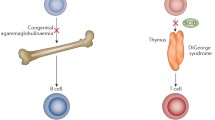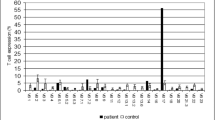Abstract
Severe combined immunodeficiency (SCID) is a condition characterized by lack of cellular and humoral immunity. Uniformly fatal before 1968, SCID was first cured by allogeneic bone marrow transplantation (BMT). Despite improvements in BMT, particularly for cases in which there is no matched related donor, difficulties in SCID treatment persist. Because of incomplete reconstitution and transplant-related complications, gene therapy has been pioneered in SCID with success, but also adverse events in the form of leukemic proliferations related to retroviral insertional mutagenesis. Infectious complications are a major limitation to effective treatment. Early diagnosis of SCID in the pre-symptomatic period could be achieved by population-based newborn screening.
Similar content being viewed by others
References
Puck JM. X-linked severe combined immunodeficiency. In: Ochs H, Smith CIE, Puck JM, editors. Primary immunodeficiency diseases, a molecular and genetic approach. 2nd ed. New York, NY: Oxford University Press; 2007 (Chapter 9)
Gatti RA, Meuwissen HJ, Allen HD, Hong R, Good RA. Immunological reconstitution of sex-linked lymphopenic immunological deficiency. Lancet 1968;7583:946–7
Haddad E, Landais P, Friedrich W, et al. Long term immune reconstitution and outcome after HLA-nonidentical T-cell depleted bone marrow transplantation for severe combined immunodeficiency: a European retrospective study of 116 patients. Blood 1998;91:3646–53
Buckley RH, Schiff SE, Schiff RI, et al. Hematopoietic stem cell transplantation for the treatment of severe combined immunodeficiency. New Engl J Med 1999;340:508–16
Antoine C, Muller S, Cant A, et al. Long-term survival and transplantation of hematopoietic stem cells for immunodeficiencies: report of the European experience 1968–1999. Lancet 2003;361:553–6
Buckley RH, Fischer A. Bone marrow transplantation for primary immunodeficiency diseases. In: Ochs H, Smith CIE, Puck JM, editors. Primary immunodeficiency diseases, a molecular, genetic approach. 2nd ed. New York NY: Oxford University Press; 2007 (Chapter 47)
Cavazzana-Calvo M, Hacein-Bey S, de Saint Basile G, et al. Gene therapy of human severe combined immunodeficiency (SCID)-X1 disease. Science 2000;288:669–72
Aiuti A, Slavin S, Aker M, et al. Correction of ADA-SCID by stem cell gene therapy combined with nonmyeloablative conditioning. Science 2002;296:2410–3
Gaspar HB, Parsley KL, Howe S, et al. Gene therapy of X-linked severe combined immunodeficiency by use of a pseudotyped gammaretroviral vector. Lancet 2004;364:2181–7
Hacein-Bey-Abina S, Von Kalle C, Schmidt M, et al. LMO2-associated clonal T cell proliferation in two patients after gene therapy for SCID-X1. Science 2003;302:415–9
Chinen J, Davis J, De Ravin SS, et al. Gene therapy improves immune function in pre-adolescents with X-linked severe combined immunodeficiency. Blood 2007 (in press)
Douek DC, McFarland RD, Keiser PH, et al. Changes in thymic function with age and during the treatment of HIV infection. Nature 1998;396:690–5
Myers LA, Patel DD, Puck JM, Buckley RH. Hematopoietic stem cell transplantation for SCID in the neonatal period leads to superior thymic output and improved survival. Blood 2002;99:872–8
Chan K, Puck JM. Development of population-based newborn screening for severe combined immunodeficiency. J Allergy Clin Immunol 2005;115:391–8
Acknowledgments
Thanks to co-investigators Harry Malech and Javier Chinen and the entire NIH gene therapy team, Kee Chan for TREC assay development, Susan Panny of the Maryland newborn screening program, and the patients and their physicians who made these studies possible.
Author information
Authors and Affiliations
Corresponding author
Additional information
Presented at the First Robert A Good Society Symposium, St. Petersburg, FL 2006.
Rights and permissions
About this article
Cite this article
Puck, J.M. Severe combined immunodeficiency: new advances in diagnosis and treatment. Immunol Res 38, 64–67 (2007). https://doi.org/10.1007/s12026-007-0029-8
Published:
Issue Date:
DOI: https://doi.org/10.1007/s12026-007-0029-8




